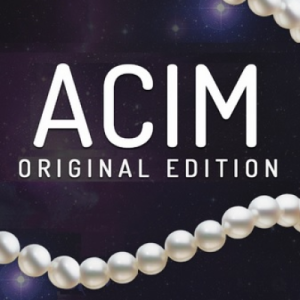The following article is an adaptation from the MIRACLES HEALING CENTER FULL Article “The Rhythm & Reason of Reality ~ Prose and Poetry in A Course in Miracles
THE RHYTHM AND REASON OF REALITYThose of you who have discovered the unearthly masterpiece,
A Course in Miracles, will no doubt be aware of, and grateful
for, its divine message of the remembrance of God and reality
through love and forgiveness, that are only made possible in
the realization that this world is a dream of your own making.
You may remember reading, amongst the literature concerning the
scribing of the Course, references to the use of a poetic form
called iambic pentameter.The purpose of this volume is to present the poetry of the
Course in a totally accessible manner. You need know nothing
about poetic forms and meters to begin enjoying immediately.
You may, however, wish to read this introduction, as a search
to ascertain the extent of the poetic form within the Course
reveals another astounding dimension in its structural
integrity.Iambic pentameter is usually described as “lines consisting of
five iambs”, which in turn are described as “metric feet of two
syllables each, the second syllable being the stronger”. Put
simply, a line of iambic pentameter sounds like this:|Da-DUM |Da-DUM |Da-DUM |Da-DUM| Da-DUM | — |
This form is also called “blank verse”, a more general term
denoting even rhythm without rhyming. Because the Course is
presented entirely as prose the extent to which this form is
used is a surprising and exciting discovery.The Text of A Course In Miracles can be seen as three distinct
parts, two of twelve chapters each, and the last of seven
chapters, each differentiated from the other by the use of
meter. Within this structure, a gradual transition is made
from prose to blank verse.The first twelve chapters of the Course are written in a
rhythmic prose, and the portrait of the human condition given
is prosaic indeed. The very last sentence of Chapter 12 is the
first glimpse of what, metrically speaking, is to come: “Your
Father could not cease to love His Son. (a line of iambic
pentameter)The second part begins with the first seven sections of Chapter
13 becoming increasingly iambic, until in section seven, “The
Attainment of the Real World”, each paragraph contains on
average only three of four arhythmic lines, non-iambic lines.
This is the metric characteristic of the second twelve chapters.
Occasionally, paragraphs begin with emphatic statements of
light reality, given in iambic pentameter: “There is a light
that this world cannot give;” is the first such occurrence. “You
do not really want the world you see;” “We cannot sing
redemption’s hymn alone;” “Your faith in nothing is deceiving
you.” These glorious statements are each elucidated
conceptually in the paragraphs that follow from them, but each
also offers an opportunity to enter into real communication….
You are being prepared for a new mode of data
transmission.Deeper into the second part, increasingly strong “insertions”
of iambic pentameter occur; longer passages that persist
further into the paragraphs. For instance, in Chapter 21:Thus they define their life and where they live,
adjusting to it as they think they must,
afraid to lose the little that they have.
And so it is with all who see the body
as all they have and all their brothers have.
and fail again.Coincident with the approach of total iambic pentameter, (the
last seven chapters), Jesus makes this statement (in Chapter
22): “This is a crucial period in this course, for here the
separation of you and the ego must be made complete.”
And this:This course will be believed entirely
or not at all.
For it is wholly true or wholly false,
and cannot be but partially believed.Chapter 25 is the beginning of the final part. In Chapters 25
and 26 the final transition is made into perfect iambic
pentameter, making feasible the presentation as poetry in the
two same manner as the works of Shakespeare are presented,
with columns of the short blank verse lines to a page. It is at
this final part that this volume of transformative rhythm and
poetry takes up the Text. Encoded into the ongoing
presentation of conceptual ideas is the true communication the
Course aims to teach. Each line is a perfectly whole package
of information.Some parts of these two chapters are still not regular enough
to allow breakdown into lines of iambic pentameter and so are
presented (in Russell’s book) as prose. Also, the regular
iambic pentameter in these two chapters and early in Chapter
27, often contains idiosyncrasies, such as lines that contain
one extra syllable, or short lines of only four or six
syllables. These discrepancies are used to emphasize ideas in
the same manner that the iambic pentameter was used in the
middle chapters of the text, only rather than lifting you into
communication, they drop you out momentarily, the aim being
to teach you to recognize the difference.In the last five chapters of the text the iambic pentameter is
perfect. Jesus never abbreviates words to achieve this, but it
does account for what seemed to be occasionally unusual syntax
– but which now makes perfect sense, read as poetry.A transition from prose to poetry also occurs in the Workbook,
but it is much simpler, and quicker. The first ninety lessons
are plain prose, with the exception of Lesson 78, which is
totally poetic (iambic pentameter). The transition occurs
entirely with ten lessons. Lesson 91 is prose. The following
lessons have increasing percentages of verse, but the
distinction is kept very clear. Any paragraph will either be
entirely prose, or entirely poetry. It is astonishing to
discover that everything in the Workbook from lesson 100 on is
in iambic pentameter ~ the introductions to Reviews, the
“instructions on themes of special relevance,” such as ‘What is
Forgiveness’, the prayers and the Epilogue.Attempts to read the poetic form directly from the original
prose layout often result in diminished comprehension.
Conversely, the presentation as blank verse guarantees placing
correct emphasis for understanding, (though not understanding
itself), and the elegance and eloquence of Jesus’ poetry and
the regular rhythmic lope offer an expanded experience of the
Course to the musical mind.The magnitude and beauty of the Course, simply as a work of
literature and without regard to its miraculous content,
adequately belie any notion of its human authorship. The
divinity of the ideas expressed is beyond question. Certainly
the poetic and prosaic forms contained in A Course in Miracles
are there because that was necessary for the healing of God’s
Son, since this is the Holy Spirit’s only purpose.


I’d have to check with you here. Which is not something I regularly do! I enjoy reading a post that will make habitancy think. Also, thanks for allowing me to comment!
LikeLike